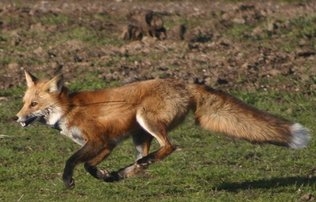UC Blogs
Take action to help improve red fox conservation efforts
The red fox (Vulpes vulpes) is one of the most widely distributed terrestrial mammals in the world. California is home to red foxes of both native and non-native ancestry. Red foxes in the Sacramento Valley were long thought to be non-native. However, in 2005 genetic analyses performed in the UC Davis School of Veterinary Medicine’s, Veterinary Genetics Laboratory revealed these foxes to be native to the region and potentially in decline.
The estimated population size of Sacramento Valley (SV) red foxes is very small, indicating possible conservation concerns. In addition, SV red foxes occur in a highly modified landscape used for intensive agriculture. In particular, while preliminary analyses indicate that the current distribution of SV red foxes in the northern part of the Central Valley overlaps a floodplain once characterized by native grasslands and riparian forests, these habitats have been heavily modified to meet agricultural needs. The continuous modification of habitats for agriculture in the SV may be impeding on the limited habitats available to foxes, particularly since these foxes only live at low elevations.
Based on their unique natural history and their close proximity and dependency on human modified landscapes, SV red foxes face multiple threats. Direct threats include deaths attributed to a variety of causes: residents protecting their poultry, vehicle collisions, exposure to pathogens from domestic animals, and ingestion of poison bait meant for rodent control or eating rodents killed by poison. Additional threats for the viability of SV red foxes are the species’ limited range and distribution. Species isolated in a single region with a small population, like the SV red fox, experience minimal genetic variation in their gene flow, and could potentially face genetic introgression from adjacent non-native populations. These threats, which are likely increasing over time, may warrant placing the SV red fox on the threatened species list in the near future.
In 2007, an online reporting system was launched by the University of California, Davis, with goals of involving the public in documenting any potential fox sightings. The goal of this website was to involve the local community with locating SV red foxes so that samples could be obtained for genetic testing and surveillance could be set up for behavior monitoring.
Now, master's student Amy Brasch of Victoria University of Wellington is assessing how effective public input was on locating the foxes and how the website can be improved for future conservation efforts.
You are invited to share your opinions regarding red foxes and the fox sighting website in a 5-minute survey located on the fox sighting website: http://foxsurvey.ucdavis.edu/
The results of this survey will enhance the website as well as develop a better understanding of how effective public input is on locating Sacramento Valley red foxes.
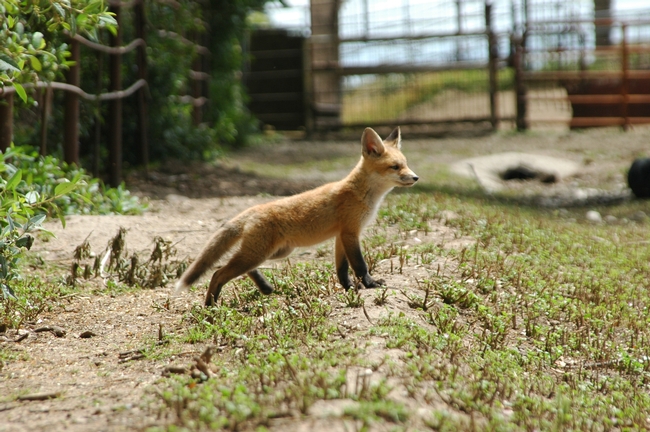
Sacramento Valley fox pup. (Photo: Mark Statham)
Debut Event of UC Davis Honey and Pollination Center
If you want to know more about honey and pollination, then mark your calendar for Saturday, Oct. 27. That's the date of the debut event of the newly...
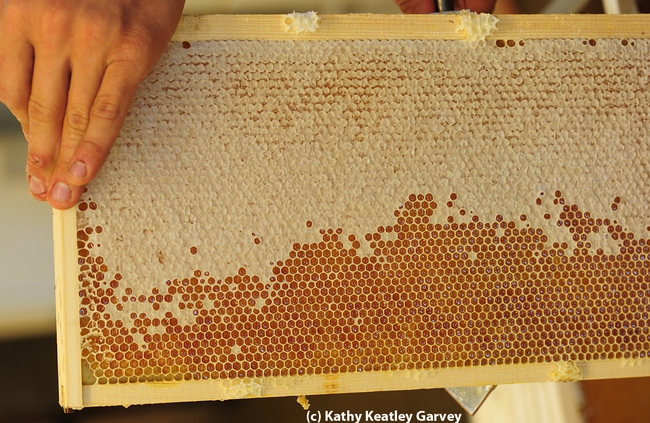
A frame of honey from the Harry H. Laidlaw Jr. Honey Bee Research Facility, UC Davis. (Photo by Kathy Keatley Garvey)

Ready to greet visitors are RMI executive director Clare Hasler-Lewis (left) and event coordinator Tracy Dickinson. (Photo by Kathy Keatley Garvey)

RMI executive director Clare Hasler-Lewis at the RMI's Silverado Vineyards Sensory Theatre. (Photo by Kathy Keatley Garvey)
UC's red walnut featured in Fresno Bee
The lead food story in the Fresno Bee this week focused on walnuts and their local availability. An important component of the story was the red walnut, a cultivar developed by University of California breeders a decade ago.
Most walnuts grown in California have a light tan seed coat. The "Robert Livermore" walnut has a red seed coat.
"It has a very interesting color and gives consumers and farmers another option," said Chuck Leslie, staff research associate in the Department of Plant Sciences at UC Davis.
Leslie says the nut does not taste significantly different than ordinary walnuts to him. Fresno Bee reporter Robert Rodriguez quoted a Sacramento food blogger in the story who said the red walnut has a milder flavor and works well in recipes ranging from salads to cookies.
UC's red walnut was named after the late Lake County walnut grower Robert Livermore, said Rachel Elkins, UC Cooperative Extension advisor for Lake and Mendocino counties. The Livermore family owns a historic ranch on Mt. St. Helena that is still in operation.
"Robert Livermore contributed to the breeding program and hence the walnut was named for him," Elkins said. "He managed the Bishop Ranch in San Ramon which is now a large commercial business park, but was a very large fruit and nut ranch."
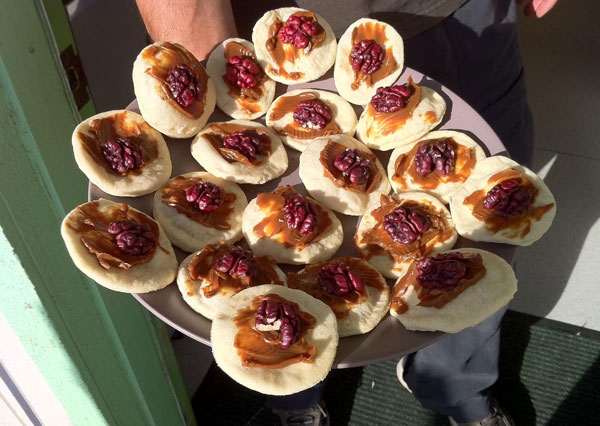
Red walnuts brighten up a plate of cookies.
Crape Myrtle Madness
When our family moved from the Bay Area to Vacaville five years ago, I looked forward to warm fog-less summers sitting beside the swimming pool in our small backyard. But I found out that sitting is a rare occurrence since seven 20-year old Redwood trees (Sequoia sempervirens) and three Crape myrtles (Lagerstoemia indica) border the pool. When my husband and I aren't scooping out cones and needles, we're glaring at the myrtle trees bursting with aerodynamic blooms fit for the slightest breeze.
We determined that this year would be different. By late-July we hatched a plan to conquer the blossom drop. Before the petals started falling, we started pruning. One by one, flower clusters plopped onto the walkway. By day’s end our green-waste can sat at the curb like a stuffed Thanksgiving turkey. My husband and I sank into our faux wicker chairs with pretzels and cokes in hand. We grinned from ear to ear, thrilled that these skinny-dipping blossoms were history. Finally, time to relax.
“Hey, Honey, we'll have a clean pool for a couple months before the autumn winds shake down the dead redwood needles,” I told my husband.
Wrong. By Labor day, I was staring at Crape myrtle buds—again. In fact, they sprouted from every single cut our pruners had made and by mid-September the trees were thick with flowers. Oops, I had unknowingly coaxed a second bloom out of the trees. Next year we'll return to our usual once-a-year early spring pruning regime of removing the prior year’s seed capsules, enjoying the flower show—and putting up with the maddening scattering mess.

Crape myrtle buds. (photos by Launa Herrmann)

Crape myrtle blooms.
A Bug-Eat-Bug World
It's a bug-eat-bug world out there. Today we watched a syrphid fly, aka "hover fly" and "flower fly," circling a blanket flower (Gaillardia) and...
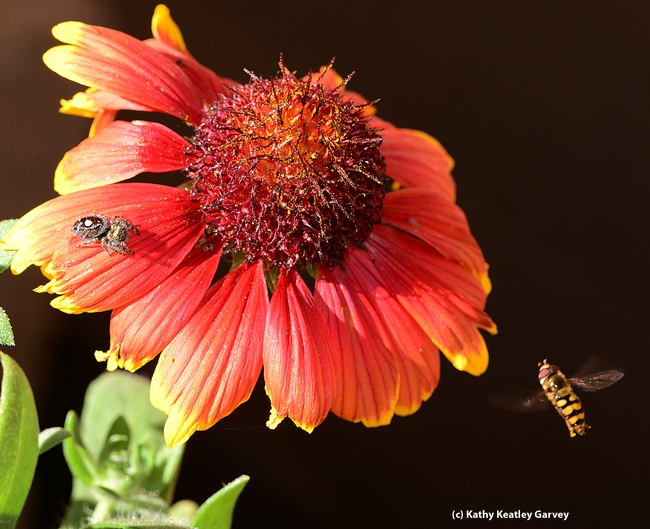
Syrphid fly (right) circles a blanket flower, unaware of the jumping spider. (Photo by Kathy Keatley Garvey)
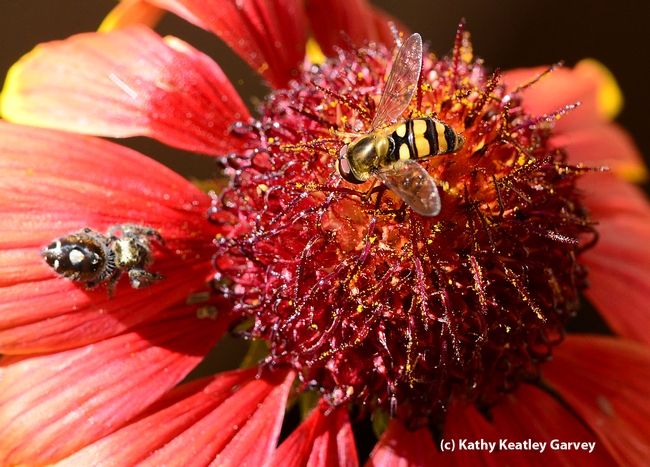
Syrphid fly sipping nectar close to the predator. (Photo by Kathy Keatley Garvey)

End result--the jumping spider feasting on the syrphid fly. (Photo by Kathy Keatley Garvey)


